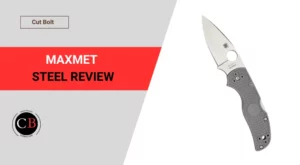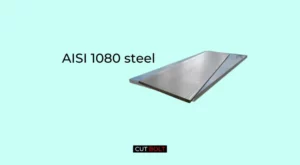Knives are like real life – the more you grow up, the wider your horizons become. In other words, once you get past the popular steels and your eyes widen to everything else out there, it starts to get interesting.
Yes and what else is out there? M2 tool steel, for example. But is M2 steel good for knives?
M2 steel is not a new creation at all. On the contrary, it has been around for quite a long time and many knife manufacturers, including big names like Gerber and Benchmade, use it.
I have tried to gather all the relevant information such as its hardness, composition, it’s suitability as a knife steel, etc. So if you want to know more about M2 tool steel stay tuned and read on.
What is M2 tool steel?
M2 tool steel is a high-speed steel with a high molybdenum content and produced for highly wear-resistant cutting tools. It is a popular choice for both specialty and high-end knives. M2 steel is also suitable for cold work applications such as punching, forming and pressing.
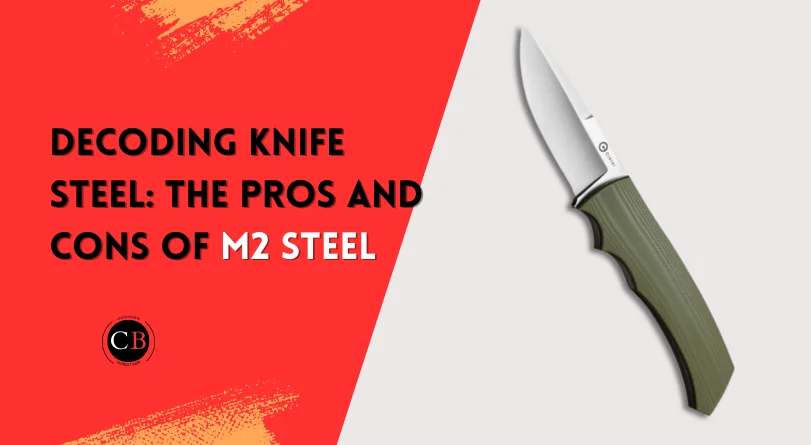
M2 steel chemical composition
| Element | Portion | Effect |
| Chrome | 4.5% | Improves wear resistance, heat resistance and scale resistance. It increases tensile strength because it acts as a carbide former. Use of rust-free or stainless steel, as it increases corrosion resistance from a mass proportion of 12.2%. Reduction in weldability. |
| Carbon | 1.05% | Increasing hardness and tensile strength. In larger quantities, increase in brittleness and a reduction in forgeability and weldability. |
| Copper | 0.25% | Improving weather resistance (surface oxidation). |
| Manganese | 0.4% | Improves hardness and tensile strength. |
| Molybdenum | 5.5% | Improves hardenability, tensile strength and weldability. Reduction in forgeability and ductility. |
| Nickel | 0.3% | Nickel increases tensile strength and yield strength. From 8% increase in corrosion resistance. |
| Phosphorus | 0.03% | Increases tensile strength, hardness and corrosion resistance but also brittleness. |
| Sulfur | 0.03% | Increases machinability but also brittleness. |
| Silicon | 0.45% | Improves strength. |
| Vanadium | 2.2% | Increasing hardness, increasing wear resistance and improving tempering resistance. |
| Wolfram | 6.75% | Increase in heat strength, tempering resistance and wear resistance at high temperatures up to red heat. |
As you can see, M2 tool steel is a combination of high tungsten, nickel and chromium content, resulting in a hard steel with great toughness and corrosion resistance.
Does M2 rust, or is M2 a stainless steel?
M2 tool steel is neither a rust-free steel nor a stainless steel. To be considered corrosion-free steel, it would require a chromium content of at least 10.5 – 13% dissolved in the austenite or ferrite, depending on the definition (see here).
M2 steel is not a stainless steel because its sulfur and phosphorus content (so-called iron companions) exceeds 0.025% (see here).
What is the hardness (HRC) of M2 tool steel?
M2 tool steel typically has a hardness in the range of 62-65 HRC (Rockwell Hardness Scale) when properly heat-treated. This level of hardness contributes to the steel’s excellent wear resistance and cutting performance, making it a popular choice for high-speed cutting tools. Keep in mind, that specific hardness can vary based on factors such as heat treatment methods and specific applications.
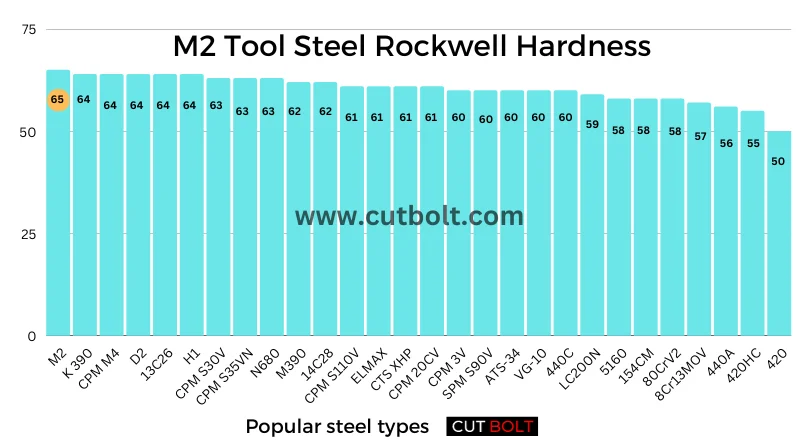
M2 steel properties
M2 tool steel, also known as High-Speed Steel (HSS), is renowned for its exceptional properties, making it a preferred choice for cutting tools. Here are key properties of M2 steel:
- Wear Resistance: M2 steel exhibits outstanding wear resistance, making it suitable for prolonged use in cutting and machining applications. M2 steel’s chemical composition, especially molybdenum and vanadium, M2 offers high wear resistance.
- Cut resistance: M2 tool steel offers good, but not optimal, cut resistance.
- High-Speed Cutting: Designed for high-speed cutting operations, M2 steel retains its hardness even at elevated temperatures, contributing to its effectiveness in machining.
- Red Hardness: M2 steel has a good red hardness, meaning it retains its hardness and cutting ability at high operating temperatures.
- Machinability: M2 is machinable in the annealed condition but becomes challenging to machine after heat treatment due to its high hardness. M2 tool steel is about 1/3 less machinable than a 1% carbon steel i.e. only moderately machinable.
- Heat Resistance: While not a true stainless steel, M2 exhibits some corrosion resistance. However, it is not as corrosion-resistant as some other tool steels.
- Toughness: Despite its high hardness, M2 maintains good toughness, allowing it to withstand high-impact forces. The toughness of M2 steel is decent, so good – according to the rule of thumb: more hardness = less toughness (and vice versa).
- Applications: Commonly used for cutting tools such as drills, taps, reamers, milling cutters, and saw blades, particularly in high-speed machining operations.
You should note that the specific properties of M2 steel can be influenced by the heat treatment process and the intended application. Proper heat treatment is crucial to achieving the desired combination of hardness and toughness.
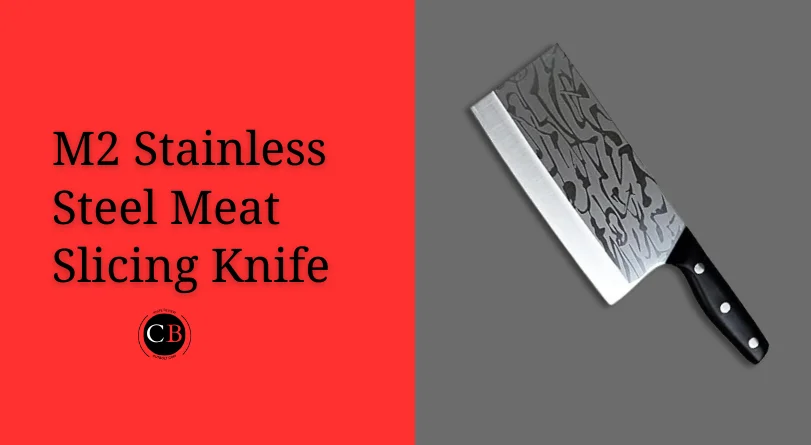
Is M2 a good knife steel?
As a mid-range tool steel, M2 is a very good knife steel. It offers good edge retention, high wear resistance and decent toughness, but needs some care (clean and oil after use…) due to its lack of corrosion resistance.
It certainly does well in an EDC, however, I would NOT want to use it permanently in a wet or corrosive environment, i.e. fishing, diving, hunting, in the kitchen, and generally in and around the ocean and similar environments.
All in all, it is a good knife steel that has been used by knife manufacturers for a long time. However, there are steels with similar or better properties for the same price or even cheaper.
M2 Tool steel equivalents
M2 tool steel probably comes closest to D2. M2 and D2 have nearly identical properties in terms of edge retention, wear resistance, hardness and toughness, but both have low corrosion resistance with D2 having higher corrosion resistance than M2. Moreover, both are used in the knife industry.
From this point of view, I would give preference to D2, since its higher corrosion resistance extends its potential range of application, perhaps not much, but at the same or even lower price.
Final Words: Is M2 steel good for knives?
In retrospect, while M2 tool steel boasts commendable qualities, especially in industrial applications, its suitability for knives has been surpassed by more cost-effective and high-performing alternatives available today.
In 2023, the market offers steels with superior performance at a more accessible price point. However, if you chance upon an M2 blade, whether as a gift or an heirloom, understanding its unique properties adds a nostalgic touch to your collection.

